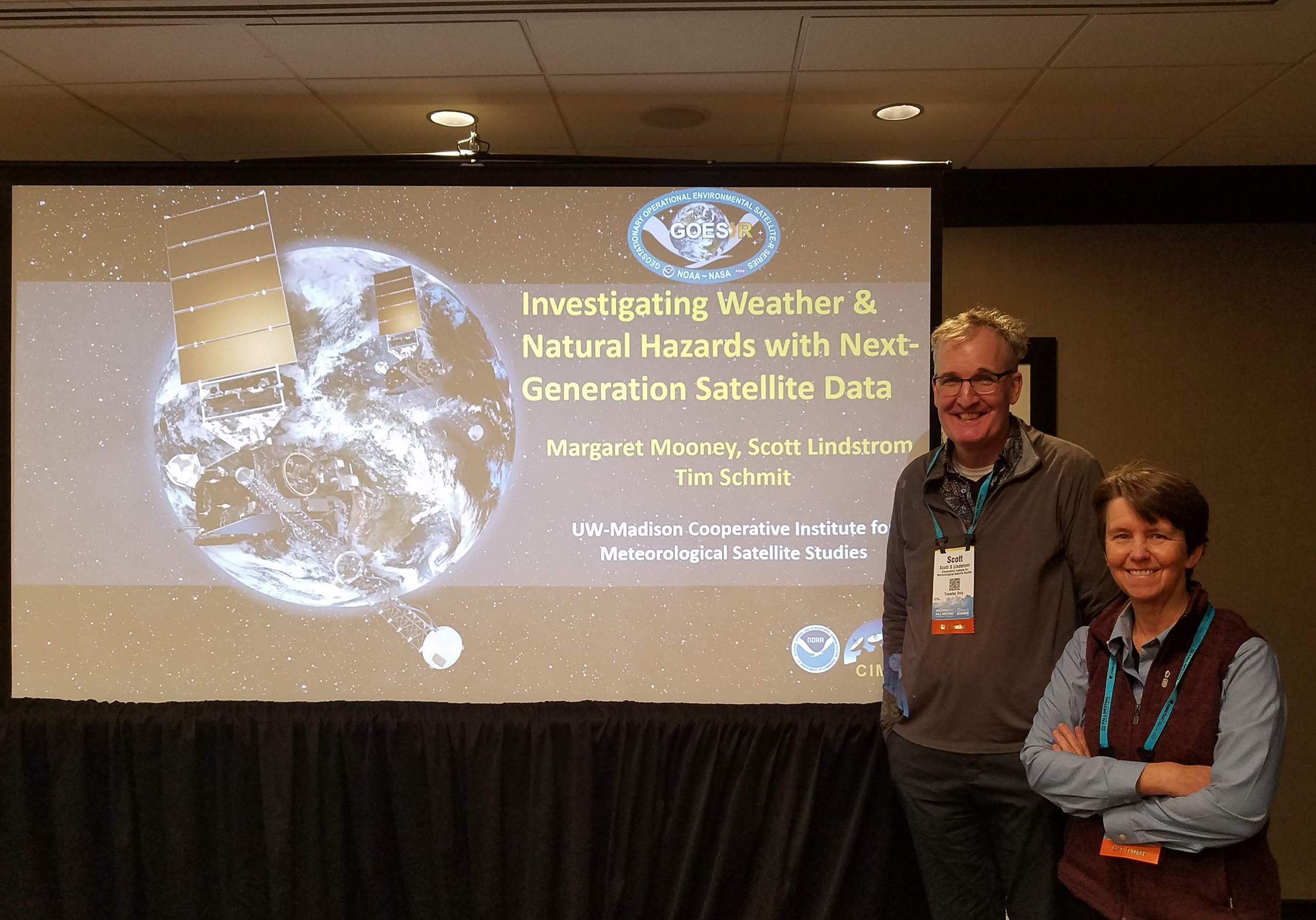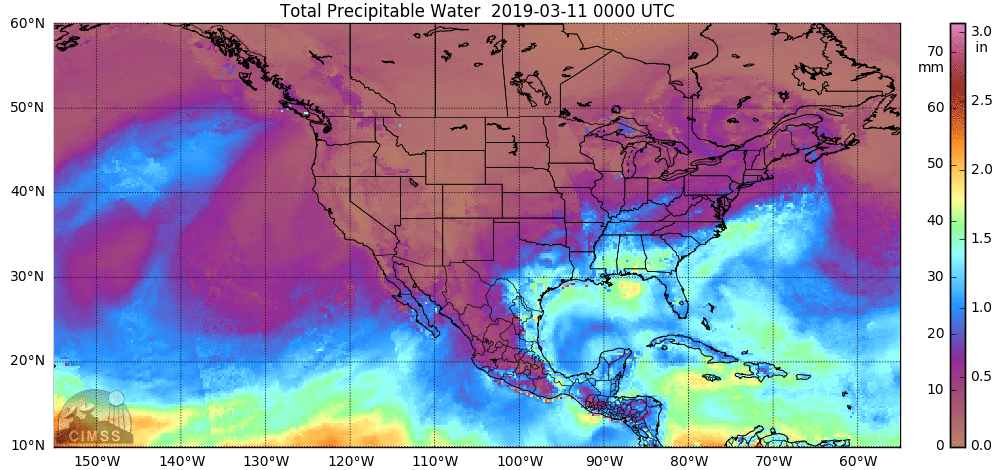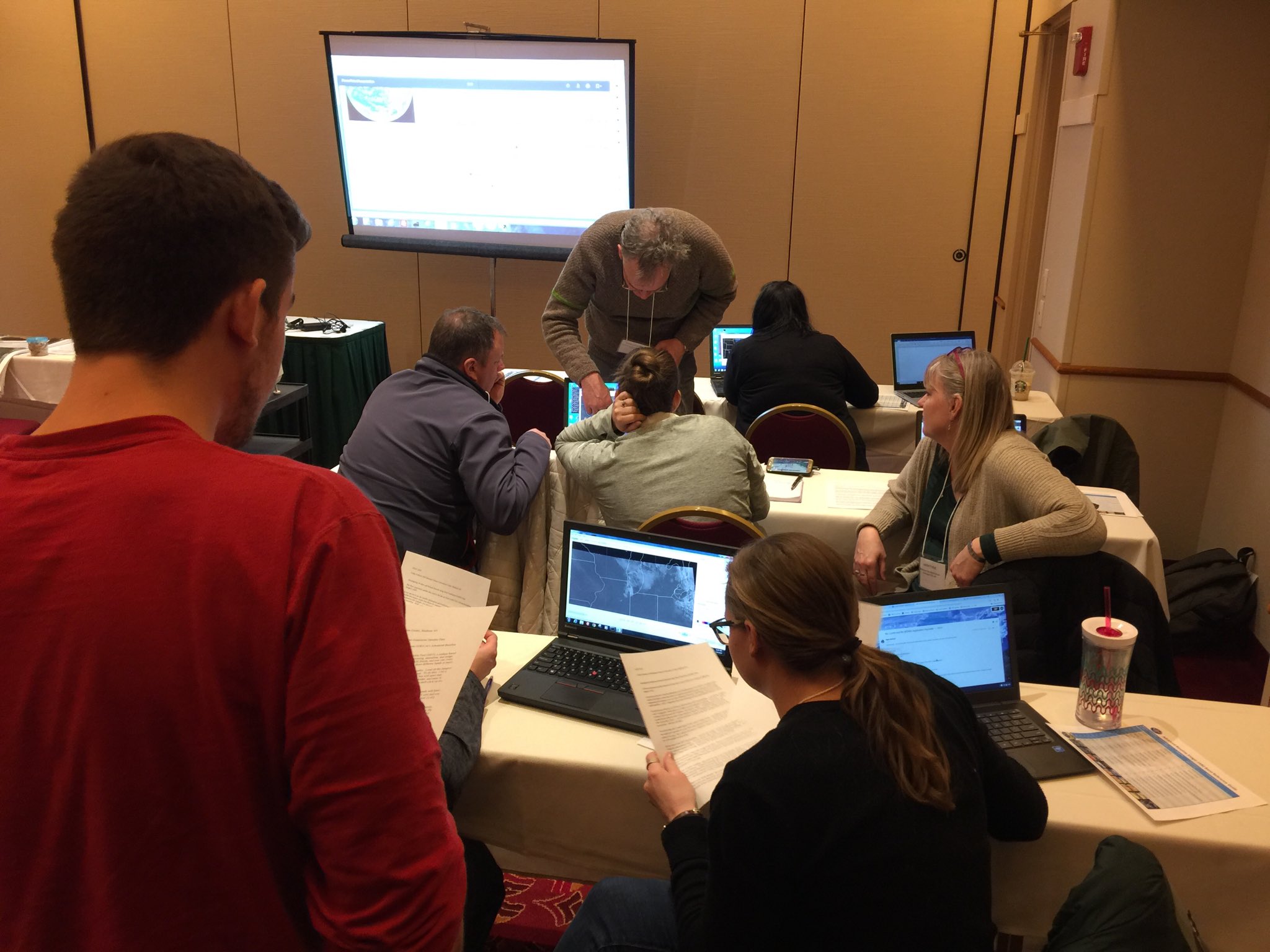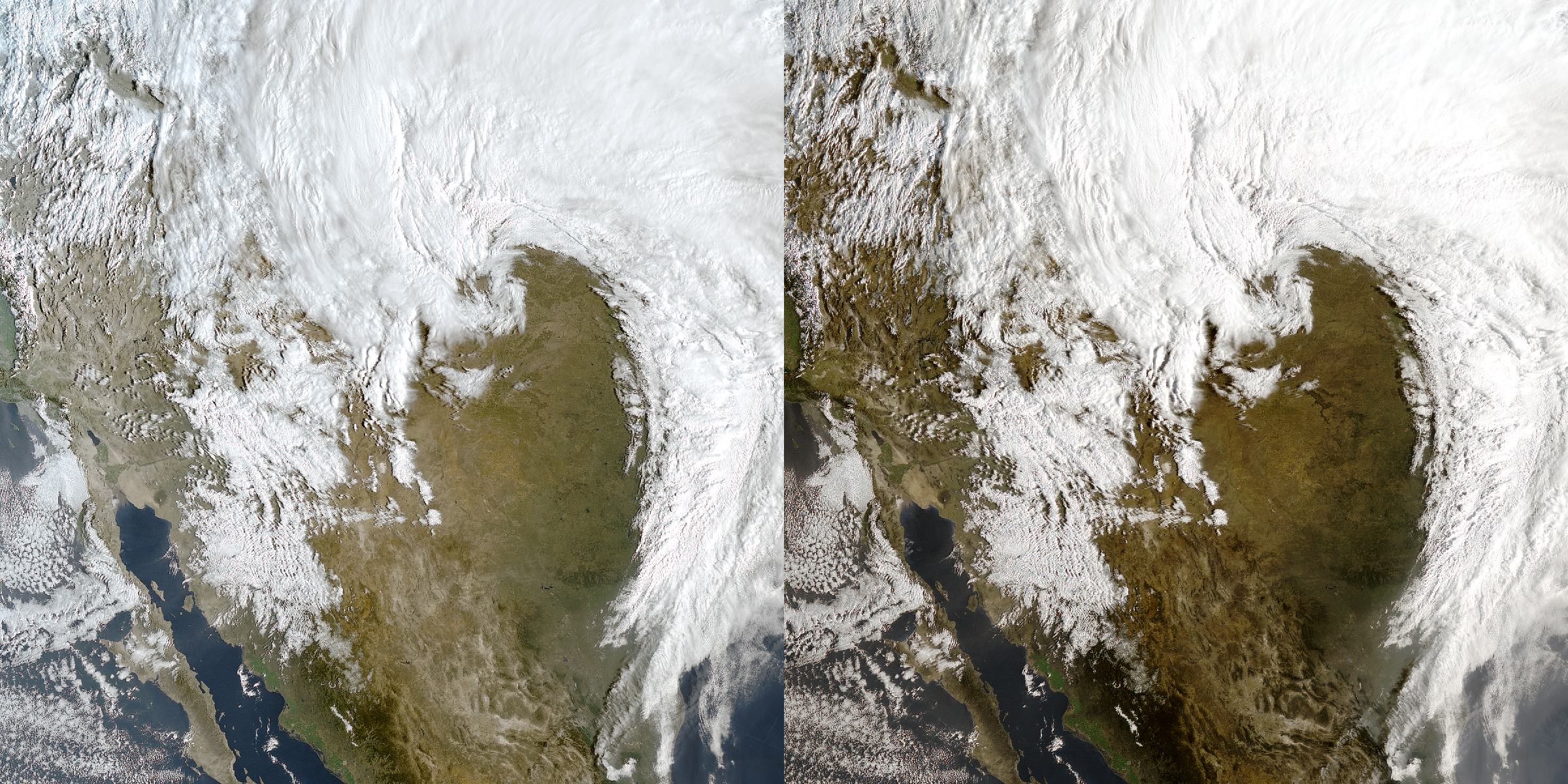
[ Archive ]

 |
CIMSS-NOAA Weekly Report [ Archive ] |
 |
ASPB AND CIMSS WEEKLY HIGHLIGHTS FOR THE WEEK ENDING MARCH 15, 2019
IN THE PRESS:
SSEC and CIMSS Scientists in the News: Scientists at the University of Wisconsin-Madison (UW) Space Science and Engineering Center (SSEC) and the Cooperative Institute for Meteorological Satellite Studies (CIMSS) provide expert commentary, interviews, and imagery to news media and participate in events to promote science. In the news this week: 1) SSEC News published a story on the 2019 Virtual Science Fair, a novel way for students and teachers to learn about, and conduct research in, satellite meteorology. Partners in the collaboration include CIMSS Education and Public Outreach Director Margaret Mooney, NOAA ASPB scientist Tim Schmit, along with Vicky Gorman, a middle school teacher from Medford, NJ and SSEC scientist Scott Lindstrom. Learn more about the fair at https://www.ssec.wisc.edu/news/articles/11831/. 2) CIMSS Satellite Blog contributor Scott Bachmeier published posts on "Cyclone Idai makes landfall in Mozambique" (Mar. 14), "Intense central US midlatitude cyclone" (Mar. 13-14), "Snow melt across the Upper Midwest" (Mar. 12), and "Dry air aloft over Wyoming and South Dakota" (Mar. 11). (M. Mooney, CIMSS, 608-265-2123, T. Schmit, E/RA2, 608-263-0291, S. Lindstrom, SSEC, S. Bachmeier, CIMSS, 608-263-3958, L. Avila, CIMSS, 608-262-0783, J. Phillips, SSEC)
 (Click image to enlarge)
(Click image to enlarge)
Figure: Scott Lindstrom and Margaret Mooney presented at the American Geophysical Union Annual Meeting in December 2018 to promote the Virtual Science Fair. Credit: CIMSS.
 (Click image to enlarge)
(Click image to enlarge)
Figure: The MIMIC Total Precipitable Water product showed the northward surge of moisture from the Gulf of Mexico as a deep, midlatitude cyclone developed over the central United States on 13 March 2019. Credit: CIMSS.
ITEMS FOR THE ADMINISTRATOR:
ITEMS FOR THE ASSISTANT ADMINISTRATOR:
ITEMS FOR THE OFFICE DIRECTOR, STAR:
GOES-R Book Chapters Submitted: On March 12th, over 90% of the Geostationary Operational Environmental Satellite (GOES)-R book chapters were submitted to the publisher, Elsevier. The book will be titled "The GOES-R Series: A New Generation of Environmental Satellites" and covers all aspects of the series, monitoring the Earth, Sun and space. Many of the chapters were written by Algorithm Working Group (AWG) team leads. This includes chapters on imagery, clouds, cyrosphere, volcanic ash, soundings, hurricane monitoring, and fires. (A. Heidinger, E/RA2, 608-263-6757, andrew.heidinger@noaa.gov; J. Key, E/RA2, 608-263-2605, jeff.key@noaa.gov; M. Pavolonis, E/RA2, 608-263-9597, mpav@ssec.wisc.edu; T. Schmit, E/RA2, 608-263-0291, tim.j.schmit@noaa.gov; J. Li, CIMSS, 608-262-3755; C. Velden, CIMSS, 608-262-9168; C. Schmidt, CIMSS, 608-262-7973)
ITEMS FOR THE DIVISION CHIEF, CoRP:
CIMSS at the Wisconsin Society of Science Teachers Meeting: Scott Lindstrom (CIMSS) and Tim Schmit (NOAA/ASPB) held a training session for almost a dozen teachers (from Middle Schools and High Schools) at the Spring Meeting of the Wisconsin Society of Science Teachers (WSST) in Madison, Wisconsin on Friday 8 March 2019. Peter Janssen, an undergraduate student in Meteorology (and Cooperative Institute for Meteorological Satellite Studies (CIMSS) student employee), assisted in that training. The training included a discussion on the history of weather satellites, on the advantages of the latest Geostationary Operational Environmental Satellite (GOES-16) over earlier satellites in observing weather over Wisconsin and on the different locations online where imagery can be obtained. The teachers also received instruction on how to use the Satellite Information Familiarization Tool (SIFT) to create imagery that helps teachers and their students diagnose what is happening in the atmosphere. Various opportunities for students -- the CIMSS Summer Student Workshop, and the CIMSS Virtual Science Fair -- were also discussed. (S. Lindstrom, CIMSS, 608 263 4425; T Schmit NOAA/ASPB ; M Mooney CIMSS)
 (Click image to enlarge)
(Click image to enlarge)
Figure: Peter Janssen (at left) and Scott Lindstrom (center) guide teachers through a SIFT Lab to create True Color imagery from GOES
Using Geo2Grid to create True Color imagery: The Community Satellite Processing Package (CSPP) for Geostationary Satellites (Geo) group at the University of Wisconsin-Madison released a Python-based software package last week, geo2grid, that allows for straightforward computation of True-Color imagery from Geostationary Operational Environmental Satellite (GOES)-16 and GOES-17 Advanced Baseline Imager (ABI) and Himawari-8 Advanced Himawari Imager (AHI). This week, two Blogs posts at the Cooperative Institute for Meteorological Satellite Studies (CIMSS) Blog (https://cimss.ssec.wisc.edu/goes/blog/archives/32318 and http://cimss.ssec.wisc.edu/goes/blog/archives/32399) guided readers through the steps needed to create imagery. Imagery included stereoscopic true-color imagery of the strong storm in the central United States on 13 March 2019. (S. Lindstrom, CIMSS, 608 263 4425 ; D. Hoese, CIMSS)
 (Click image to enlarge)
(Click image to enlarge)
Figure: GOES-16 (left) and GOES-17 (right) True Color imagery at 1500 UTC on 13 March 2019. To view the image in three dimensions, cross your eyes until three images are present, and focus on the image in the center.
Manuscript Submitted to PNAS: The manuscript "An intuitive metric to quantify and communicate tropical cyclone rainfall hazard" has been submitted to the Proceedings of the National Academy of Sciences. The work results from a collaborative effort between the Department of Civil and Environmental Engineering at the University of Wisconsin – Madison, the Department of Civil and Environmental Engineering at the University of California – Irvine, the Department of Geography at the University of Georgia, the Cooperative Institute for Meteorological Satellite Studies (Derrick Herndon), and NOAA's National Centers for Environmental Information (Jim Kossin). (J. Kossin, NOAA/NCEI/CWC, 608-265-5356)
VISITORS:
GOES-R Series Program Administrators Visit CIMSS/SSEC: Pam Sullivan, System Program Director for the GOES-R Series Program, and Ed Grigsby, Deputy System Program Director, visited the Cooperative Institute for Meteorological Satellite Studies (CIMSS) and the Space Science and Engineering Center (SSEC) on March 12, 2019. They met with CIMSS, SSEC, and local NOAA leadership and scientists. A range of topics were discussed, including current GOES-R series work and possible future directions. Short presentations by CIMSS/SSEC and NOAA scientists provided a snapshot of accomplishments for some ongoing projects, including clouds, winds, severe weather, lake effect snow, data assimilation, and GOES-17 mitigation studies. A tour of the SSEC data center and some of the engineering facilities, a demonstration of CIMSS-NWS interactions, and informal discussions on future satellite priorities rounded out the day. (T. Schmit, E/RA2, 608-263-0291, tim.j.schmit@noaa.gov; J. Key, E/RA2, 608-263-2605, jeff.key@noaa.gov)
 (Click image to enlarge)
(Click image to enlarge)
Figure: From left to right: Tim Schmit, Wayne Feltz, Pam Sullivan, Ed Grigsby, Brad Pierce, and Hank Revercomb on the roof of the Atmospheric, Oceanic, and Space Sciences Building.
NEXT WEEK:
LOOKING AHEAD:
| Archived Weeklies Page | Submit a report item |